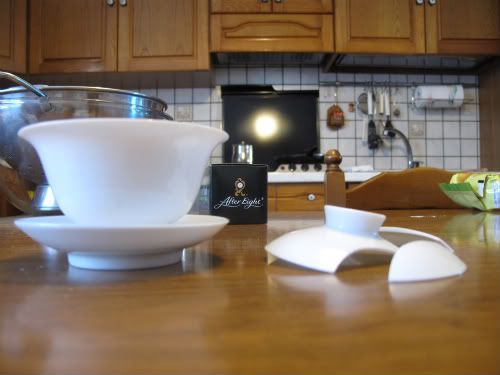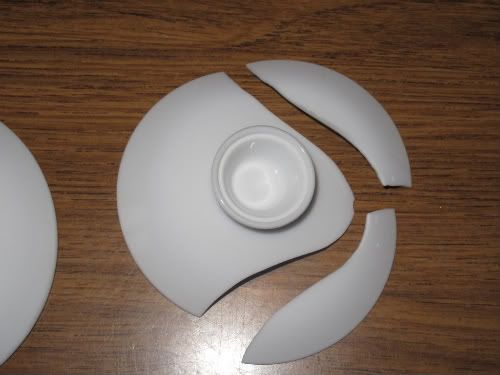the chip on my gaiwan is fine with me for nowChip wrote:... chips are ok, chips are ok, chips are ok ...
Oct 1st, '10, 12:31
Posts: 702
Joined: Sep 4th, '10, 18:25
Scrolling: scrolling
Re: Teaware Loss (Viewer discretion is advised)
Re: Teaware Loss (Viewer discretion is advised)
Chip all your tea ware on purpose and liberate yourselfChip wrote:... chips are ok, chips are ok, chips are ok ...
Re: Teaware Loss (Viewer discretion is advised)
I have a question : I have a fine teapot which suffered from a shock. The tip of the beak (2 mm) is now gone. It is not as terrible as if the whole pot got broken, but now the beak is lower than the rim of the teapot. Consequently, the water inside the teapot doesn't fill till the top and air is trapped under the cap. (I hope I am clear...  )
)
As it is a very fine teapot, previously devoted to yan cha, I still want to use it. So I was wondering which kinds of tea really need a "water-sealed" teapot and which don't. So I figured I'd ask you guys.
On which variety can I re-affect this teapot from your point of view ?
As it is a very fine teapot, previously devoted to yan cha, I still want to use it. So I was wondering which kinds of tea really need a "water-sealed" teapot and which don't. So I figured I'd ask you guys.
On which variety can I re-affect this teapot from your point of view ?
Re: Teaware Loss (Viewer discretion is advised)
Ahh...... this was the postman wasn't it?
Oh yes, wait a minute Mister Postman
Wait Mister Postman
Please Mister Postman, look and see
(Oh yeah)
If there's a Gaiwan in your bag for me
(Please, Please Mister Postman)
Why's it takin' such a long time
(Oh yeah)
For me to get that broken lid of mine
Sorry about that...couldnt help myself. Did you get any resolve from the vendor?
Oh yes, wait a minute Mister Postman
Wait Mister Postman
Please Mister Postman, look and see
(Oh yeah)
If there's a Gaiwan in your bag for me
(Please, Please Mister Postman)
Why's it takin' such a long time
(Oh yeah)
For me to get that broken lid of mine
Sorry about that...couldnt help myself. Did you get any resolve from the vendor?
Re: Teaware Loss (Viewer discretion is advised)
David R. wrote:the water inside the teapot doesn't fill till the top and air is trapped under the cap. (I hope I am clear...)
As it is a very fine teapot, previously devoted to yan cha, I still want to use it. So I was wondering which kinds of tea really need a "water-sealed" teapot and which don't.
There is one thing I don't all get, the part where there is a gap of air (under the lid? or in the pot under the rim) because the beak is diminished. When you fill the pot and let water flow over, what happens exactly ? is some water "escaping" through the beak ? I'm sure there's something I don't figure right.
(EDIT : thinking about it : if the beak is a not curved shape (less length) or is only the "minimal length" then I see how it would fail to retain all of the water, is that it ?)
(EDIT 2 : : an artisan jeweller could do something about it.
>> to give you my 2 cts on what teas really need a water sealed vessel, I would say none. when you brew in a gaiwan you can brew any tea and there is not a water seal... and this does not minor the quality of the brew. same goes for any vessel.
now a "w/ water seal result" might differ from a "w/o water seal result", but this would be one difference amongst other differences so if you have lost the water seal you need not worry and can just go on using your pot as you did.
But, it is true that some teas would benefit from a vessel not filled totally : green, white and yellow (if you use a pot and close the lid your best aromatic interest would be not to fill completely) -- but you were probably not thinking of these teas I guess.
Last edited by alan logan on Nov 1st, '10, 04:57, edited 1 time in total.
Oct 31st, '10, 12:44
Posts: 5896
Joined: Jan 10th, '10, 16:04
Location: Los Angeles, CA
Contact:
debunix
Oct 31st, '10, 12:48
Posts: 1796
Joined: Sep 15th, '09, 16:11
Location: Wilton, New Hampshire USA
Re: Teaware Loss (Viewer discretion is advised)
debunix wrote:JB weld?
Sorry, I don't have time to do any welding right now....working with wet clay.
best,
..............john
Re: Teaware Loss (Viewer discretion is advised)
Not easy to be clear with my problem, I am sorry. One can check, every teapot beak is at the same height than the rim of the pot. Just put a pen on the pot without its lid, you will realize see what I mean.
If you reduce the height of the beak, the water level will decrease in the pot accordingly.
Anyway, I found a solution to my problem. It is not the prettiest solution, but it works.
Thanks for the response.
If you reduce the height of the beak, the water level will decrease in the pot accordingly.
Anyway, I found a solution to my problem. It is not the prettiest solution, but it works.
Thanks for the response.
Nov 1st, '10, 00:01
Vendor Member
Posts: 1518
Joined: Nov 13th, '09, 10:16
Location: Guilin, Guangxi China
Contact:
IPT
Re: Teaware Loss (Viewer discretion is advised)
My chipped Zisha teapots are all in the office. It is a good excuse to keep using them and also safer than using unchipped pots. Although it still breaks my heart
Re: Teaware Loss (Viewer discretion is advised)
Zensuji wrote:Ahh...... this was the postman wasn't it?
Oh yes, wait a minute Mister Postman
Wait Mister Postman
Please Mister Postman, look and see
(Oh yeah)
If there's a Gaiwan in your bag for me
(Please, Please Mister Postman)
Why's it takin' such a long time
(Oh yeah)
For me to get that broken lid of mine
Sorry about that...couldnt help myself. Did you get any resolve from the vendor?
ROTFL
Anyway, yes, it was the postman (or someone in the postal service) and no, I didn't get any resolve from Jerry for the time being, but I was unable to produce any picture of the damaged parcel because the garbage truck had already passed when Jerry asked and I myself didn't think of getting a picture of the box in the first place, so it's my fault too I guess.
Nov 5th, '10, 18:34
Posts: 1483
Joined: Mar 19th, '06, 12:42
Scrolling: scrolling
Location: On the couch
Contact:
Proinsias
Re: Teaware Loss (Viewer discretion is advised)
not sure if I should try Chip's method with the twine or just work around the crack
Re: Teaware Loss (Viewer discretion is advised)
Proinsias wrote:
not sure if I should try Chip's method with the twine or just work around the crack

